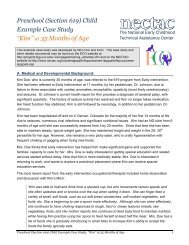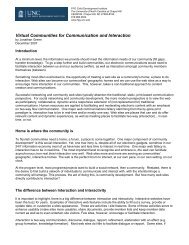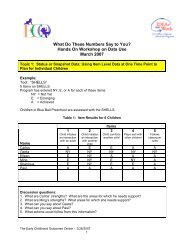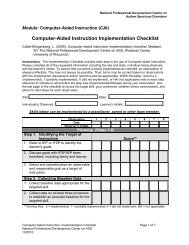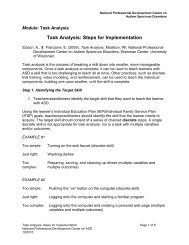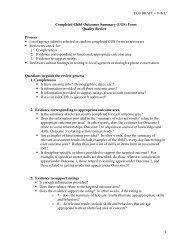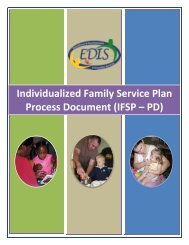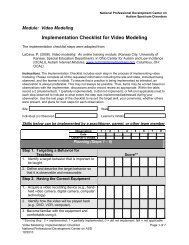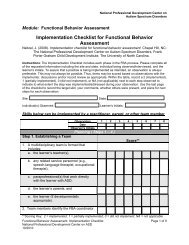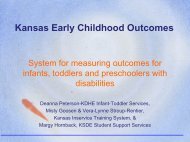Differential Reinforcement of Other Behaviors: Steps - National ...
Differential Reinforcement of Other Behaviors: Steps - National ...
Differential Reinforcement of Other Behaviors: Steps - National ...
Create successful ePaper yourself
Turn your PDF publications into a flip-book with our unique Google optimized e-Paper software.
<strong>National</strong> Pr<strong>of</strong>essional Development Center onAutism Spectrum DisordersModule: <strong>Differential</strong> <strong>Reinforcement</strong> <strong>of</strong> <strong>Other</strong> <strong>Behaviors</strong><strong>Differential</strong> <strong>Reinforcement</strong> <strong>of</strong> <strong>Other</strong> <strong>Behaviors</strong>: <strong>Steps</strong> forImplementationVismara, L., Bogin, J., & Sullivan, L. (2009). <strong>Differential</strong> reinforcement <strong>of</strong> otherbehaviors: <strong>Steps</strong> for implementation. Sacramento, CA: The <strong>National</strong> Pr<strong>of</strong>essionalDevelopment Center on Autism Spectrum Disorders, M.I.N.D. Institute, University<strong>of</strong> California at Davis School <strong>of</strong> Medicine.<strong>Differential</strong> reinforcement (DR) is a special application <strong>of</strong> reinforcement designed toreduce the occurrence <strong>of</strong> interfering behaviors (e.g., tantrums, aggression, self-injury,stereotypic behavior). The rationale for DR is that by reinforcing behaviors that are morefunctional than the interfering behavior or that are incompatible with the interferingbehavior, the functional behavior will increase, and the interfering behavior will decrease.A variety <strong>of</strong> differential reinforcement strategies can be used to increase positivebehaviors and decrease interfering behaviors. DR includes the following steps.Step 1. Identifying the Interfering Behavior1. Teachers/practitioners define the target behavior.The first step in using a DR procedure is to identify the interfering behavior. Interferingbehaviors are disruptive behaviors such as screaming or aggression orrepetitive/stereotypic behaviors (e.g., lining up toys or blocks, spinning objects, etc.) thatinterfere with learning.In addition to identifying the specific behavior that is interfering with learning, gatheringinformation from team members regarding the following aspects <strong>of</strong> the interferingbehavior will be helpful.2. Teachers/practitioners gather information from team members regarding thefollowing aspects <strong>of</strong> the interfering behavior:a. topography, or what the interfering looks like: (e.g., banging arms against thetable);b. frequency, or how <strong>of</strong>ten the behavior happens: (e.g., from once or twice perday to a dozen or more times per day);c. intensity, or how severe the behavior is: (e.g., if the behavior is biting, howhard does the learner bite and does he cause tissue damage);d. location, or where the behavior is occurring: (e.g., in gym class, on theplayground, during math class); and<strong>Differential</strong> <strong>Reinforcement</strong> <strong>of</strong> <strong>Other</strong> <strong>Behaviors</strong>: <strong>Steps</strong> for Implementation Page 1 <strong>of</strong> 10<strong>National</strong> Pr<strong>of</strong>essional Development Center on ASD10/2010
<strong>National</strong> Pr<strong>of</strong>essional Development Center onAutism Spectrum DisordersModule: <strong>Differential</strong> <strong>Reinforcement</strong> <strong>of</strong> <strong>Other</strong> <strong>Behaviors</strong>e. duration, or how long the behavior lasts: (e.g., a tantrum that lasts a fewminutes or that can last for an hour).This information can be summarized to aid in the assessment <strong>of</strong> the possible functions<strong>of</strong> the interfering behavior. For example, knowing that Joey loudly shouts pr<strong>of</strong>anitiesbetween three-four times for 30 seconds or more when in the lunchroom providesspecific information about the interfering behavior that can be <strong>of</strong> value in planningintervention.Step 2. Determining the Function <strong>of</strong> the Interfering Behavior1. Teachers/practitioners use functional behavior assessment to identify thefunction <strong>of</strong> the interfering behavior.An important part <strong>of</strong> determining the function <strong>of</strong> the interfering behavior will beinterviewing team members about the nature <strong>of</strong> the problem behavior. To do so, you willneed to complete a functional behavior assessment that will allow you to identify thecurrent antecedents and consequences. For more information about this procedure,please see Functional Behavior Assessment: <strong>Steps</strong> for Implementation (<strong>National</strong>Pr<strong>of</strong>essional Development Center on Autism Spectrum Disorders, 2008).Step 3. Identifying Data Collection Measures and Collecting Baseline Data1. Teachers/practitioners identify data collection measures to be used to assessthe interfering behavior before implementing the intervention.When collecting data for DR, it is important to focus on the frequency, topography, andintensity/severity <strong>of</strong> the behavior. Below are some examples <strong>of</strong> data sheets that may beparticularly helpful in describing the interfering behavior.Example: Frequency Data Collection SheetLearner’s name ___________________________Interfering behavior hitting___________________Date________ Observer____________________AM recess √√√√√√√√Math √√Reading √√GymMusic √√√√PM recess √√√√√√Daily Total 22<strong>Differential</strong> <strong>Reinforcement</strong> <strong>of</strong> <strong>Other</strong> <strong>Behaviors</strong>: <strong>Steps</strong> for Implementation Page 2 <strong>of</strong> 10<strong>National</strong> Pr<strong>of</strong>essional Development Center on ASD10/2010
<strong>National</strong> Pr<strong>of</strong>essional Development Center onAutism Spectrum DisordersModule: <strong>Differential</strong> <strong>Reinforcement</strong> <strong>of</strong> <strong>Other</strong> <strong>Behaviors</strong>Example: Topography Data Collections Sheet (<strong>of</strong>ten called A B C data)Learner’s name __________ Observer______________Interfering behavior hitting_____ Location math class___Date_______ Time Observed___9:30-10:15__________Antecedent Behavior ConsequenceTold to sit down Smacked arms against desk Moved to another deskAsked a math question Punched aide with closed fist Removed from classroomTold “ten minutes toreading”Smacked self with openhandsGiven silly puttyExample: Intensity Data Sheet (sometimes called a behavior rating scale)Student’s name________________ Observer_________________Date_________________________Interfering behavior hitting_______Time behavioroccurredVery severe/intense(dangerous)Behavior rating systemPrettysevere(potentiallydangerous)Somewhatsevere(causesproblemsbut is notdangerous)Not at all severe(annoying, inconvenientor distracting)9:15 4 3 2 110:05 4 3 2 110:23 4 3 2 110:40 4 3 2 111:30 4 3 2 1OverallbehaviortodayVery severe/intense (dangerous)2. Teachers/practitioners gather baseline data on the interfering behavior.The data collection measures identified above are used, along with the informationgathered in <strong>Steps</strong> 1 and 2, to determine the nature <strong>of</strong> the interfering behavior prior tothe intervention.<strong>Differential</strong> <strong>Reinforcement</strong> <strong>of</strong> <strong>Other</strong> <strong>Behaviors</strong>: <strong>Steps</strong> for Implementation Page 3 <strong>of</strong> 10<strong>National</strong> Pr<strong>of</strong>essional Development Center on ASD10/2010
<strong>National</strong> Pr<strong>of</strong>essional Development Center onAutism Spectrum DisordersModule: <strong>Differential</strong> <strong>Reinforcement</strong> <strong>of</strong> <strong>Other</strong> <strong>Behaviors</strong>During the baseline phase, it is important to collect data for a long enough period <strong>of</strong> timeto see if there is some consistency in the behavior. Teachers/practitioners shoulddecide how long data will be collected (e.g., one week, two weeks), and what willhappen if there are not enough data to inform intervention (e.g., redesign the datacollection method, observe at a different time). Baseline data collection allowsteachers/practitioners to assess the impact <strong>of</strong> the intervention on the interferingbehavior over time. Typically the behavior should be observed for three or more days indifferent settings (e.g., science class, music).3. Teachers/practitioners decide who will collect the initial data.For example, it might be easiest for a parapr<strong>of</strong>essional to collect data across the day.The team also may decide that it would be easier to have an objective observer collectdata rather than the classroom teacher who is in the middle <strong>of</strong> a lesson.Step 4. Selecting a <strong>Differential</strong> <strong>Reinforcement</strong> ProcedureThere are many types <strong>of</strong> differential reinforcement procedures included in thedesignation <strong>of</strong> DR. They include:differential reinforcement <strong>of</strong> other behaviors (DRO; e.g., reinforcing singing toreplace screaming);differential reinforcement <strong>of</strong> alternative behaviors (DRA; e.g., reinforcingshaking hands to replace slapping);differential reinforcement <strong>of</strong> incompatible behaviors (DRI; e.g., reinforcingappropriate language to replace swearing); anddifferential reinforcement <strong>of</strong> low rates <strong>of</strong> behavior (DRL; e.g., reinforcinghand raising which rarely happens).1. When deciding which procedure to use, teachers/practitioners:a. identify functionally similar behaviors (behaviors that serve the samefunctions--such as saying, “Help please” instead <strong>of</strong> grunting) that learnersalready have in their repertoire;b. determine the type and amount <strong>of</strong> functional skills (skills the learner currentlyhas that are functional alternatives to the interfering behavior—e.g., he cantap teacher on the arm to secure her attention instead <strong>of</strong> screaming);c. determine how frequently these desired behaviors occur;<strong>Differential</strong> <strong>Reinforcement</strong> <strong>of</strong> <strong>Other</strong> <strong>Behaviors</strong>: <strong>Steps</strong> for Implementation Page 4 <strong>of</strong> 10<strong>National</strong> Pr<strong>of</strong>essional Development Center on ASD10/2010
<strong>National</strong> Pr<strong>of</strong>essional Development Center onAutism Spectrum DisordersModule: <strong>Differential</strong> <strong>Reinforcement</strong> <strong>of</strong> <strong>Other</strong> <strong>Behaviors</strong>d. consider the topography (what the behavior looks like), the frequency <strong>of</strong> theinterfering behavior, how severe the behavior is, how the behavior is affectingthe environment, and where the behavior is most likely to occur; ande. consider their own pr<strong>of</strong>essional judgment and comfort level with the proposedprocedure.The matrix below may be helpful in making decisions about which differentialreinforcement procedures to use.Topography(what the interferingbehavior looks like)Unacceptable (studentlooks extremely out <strong>of</strong>place and odd, e.g.,twirling in circles in thelunch room.)Severity/intensityVery severe/intense(dangerous)Frequency<strong>of</strong>interferingbehaviorConstantImpact onenvironmentSevere (verydistracting ordisruptive)ProceduretoconsiderDRI<strong>Differential</strong> <strong>Reinforcement</strong> <strong>of</strong> <strong>Other</strong> <strong>Behaviors</strong>: <strong>Steps</strong> for Implementation Page 5 <strong>of</strong> 10<strong>National</strong> Pr<strong>of</strong>essional Development Center on ASD10/2010
<strong>National</strong> Pr<strong>of</strong>essional Development Center onAutism Spectrum DisordersModule: <strong>Differential</strong> <strong>Reinforcement</strong> <strong>of</strong> <strong>Other</strong> <strong>Behaviors</strong>Topography(what the interferingbehavior looks like)Odd/bizarre or differentSlightly odd but notenough to cause stigmaWithin what would beexpected for a similaraged studentSeverity/intensityPrettysevere(potentiallydangerous)Somewhatsevere(causesproblems butis notdangerous)Not at allsevere(annoying,inconvenientordistracting)Frequency<strong>of</strong>interferingbehaviorFrequentOccasionalRarelyImpact onenvironmentSignificant(disruptsenvironmentbut notseverely)Tolerable(environmentis impactedto a tolerableamount)Minimally(minimalimpact onenvironment)ProceduretoconsiderDRI orDRLDRO orDRADRO,DRA, orDRHStep 5. Creating an Intervention PlanWhen creating a DR intervention plan, teachers/practitioners need to address severalfeatures.1. Teachers/practitioners define other procedures that will be incorporated (e.g.,extinction, functional communication training) with the differential reinforcementprocedure. For example, a teacher/practitioner who decides to use DR for bitingmay also need to use functional communication training to teach the learner howto make requests.2. Teachers/practitioners administer a reinforcer assessment to identify learnerpreferredobjects and activities that can be used as rewards for demonstratingthe replacement behavior. The goal is to motivate the learner with tangiblerewards for demonstrating a more positive, acceptable behavior that serves thesame function as the problem behavior. The reinforcer assessment can be asinformal as displaying a variety <strong>of</strong> objects or pictures <strong>of</strong> objects/activities relatedto the learner’s interest and observing what the learner consistently chooses. In<strong>Differential</strong> <strong>Reinforcement</strong> <strong>of</strong> <strong>Other</strong> <strong>Behaviors</strong>: <strong>Steps</strong> for Implementation Page 6 <strong>of</strong> 10<strong>National</strong> Pr<strong>of</strong>essional Development Center on ASD10/2010
<strong>National</strong> Pr<strong>of</strong>essional Development Center onAutism Spectrum DisordersModule: <strong>Differential</strong> <strong>Reinforcement</strong> <strong>of</strong> <strong>Other</strong> <strong>Behaviors</strong>addition, asking the learner (if possible) and parents/family members aboutpreferred reinforcers should be considered. Keep in mind that the learner’sinterest in reinforcers may decrease or change over time. For example, thelearner’s initial desire to “work” for time on the computer after completingassignments may no longer be a preferred reinforcer. When learner preferenceschange, other favorite objects/activities can be <strong>of</strong>fered for selection. For moreinformation aobut reinforce assessment, please see <strong>Reinforcement</strong> Module(<strong>National</strong> Pr<strong>of</strong>essional Development Center on Autism Spectrum Disorders, 2009)at www.autisminternetmodules.org.3. Teachers/practitioners decide on a schedule <strong>of</strong> reinforcement (how frequently thereinforcer is delivered). For example, decide on whether the learner gets areward every time he engages in the replacement behavior or a reward for going10 minutes without engaging in the interfering behavior.4. Teachers/practitioners establish criteria for changing the schedule <strong>of</strong>reinforcement. For example, after three sessions in which the learner isreinforced every 5 minutes, he/she will be reinforced every 10 minutes for thefollowing three sessions. For more information about this procedure, pleasesee Positive <strong>Reinforcement</strong>: <strong>Steps</strong> for Implementation (<strong>National</strong>Pr<strong>of</strong>essional Development Center on Autism Spectrum Disorders, 2008).5. Teachers/practitioners specify the timeline for data collection. For example, theteam decides that data should be reviewed after one week <strong>of</strong> implementation toidentify the following week’s schedule <strong>of</strong> data collection (to monitor studentprogress).6. Teacher/practitioners clearly write-out the intervention plan and make it availableto other team members.The matrix below provides samples <strong>of</strong> four possible intervention plans based oncommon functions <strong>of</strong> interfering behavior. Each <strong>of</strong> the hypothesized functions is pairedwith DR procedures, examples <strong>of</strong> how the procedure might be implemented, and otherbehavior procedures that might be used in conjunction with DR.Function <strong>of</strong>InterferingBehaviorAttention<strong>Differential</strong><strong>Reinforcement</strong>ProcedureReinforceappropriate anddesired attempts toget attention.ExampleTeach learner to usepictures and/or handgestures to getattention. Reinforce<strong>Other</strong> PotentialBehavioralProceduresFunctionalCommunicationTraining (FCT)Extinction<strong>Differential</strong> <strong>Reinforcement</strong> <strong>of</strong> <strong>Other</strong> <strong>Behaviors</strong>: <strong>Steps</strong> for Implementation Page 7 <strong>of</strong> 10<strong>National</strong> Pr<strong>of</strong>essional Development Center on ASD10/2010
<strong>National</strong> Pr<strong>of</strong>essional Development Center onAutism Spectrum DisordersModule: <strong>Differential</strong> <strong>Reinforcement</strong> <strong>of</strong> <strong>Other</strong> <strong>Behaviors</strong>Escape/avoidSensory/autonomic(Behavior isreinforcedbecause it feelsgood orbecauselearner canescapediscomfort. )Tangible(to gain items,toys, etc.)Reinforce requestsfor breaks.Identify movement,sounds or actionsthat are reinforcing.Find ways that thosesounds ormovements canoccur without theinterfering behaviorand reinforce thoseactivities.Reinforce the learnerfor requestingappropriately.the desired behaviorby immediatelyresponding to theappropriate attempt.Create a system forrequesting breaks(e.g., picture cards)and reinforce attemptsby giving a break assoon as desiredbehavior isdemonstrated.Teach a learner whobangs his head on thewall to put his head ina s<strong>of</strong>t space where hecan not hurt himselfand reinforce him forusing the appropriatespace.Teach learner whoscreams for thecomputer to waitquietly for a timer tobuzz. Reinforce byallowing him/her to usethe computer.Non-contingent<strong>Reinforcement</strong>FunctionalCommunicationTraining (FCT)ExtinctionNon-contingent<strong>Reinforcement</strong>ResponseRedirection andInterruptionFunctionalCommunicationTraining (FCT)ExtinctionNon-contingent<strong>Reinforcement</strong>FunctionalCommunicationTraining (FCT)ExtinctionNon-contingent<strong>Reinforcement</strong>Step 6. Implementing the InterventionThe next step in using a DR procedure is to implement the intervention plan that hasbeen developed. During implementation <strong>of</strong> a DR procedure, two components should beaddressed.1. Before the interfering behavior occurs, teachers/practitioners should:a. choose which behavior to reinforce based on the intervention plan.b. explicitly teach the replacement or alternative skills.<strong>Differential</strong> <strong>Reinforcement</strong> <strong>of</strong> <strong>Other</strong> <strong>Behaviors</strong>: <strong>Steps</strong> for Implementation Page 8 <strong>of</strong> 10<strong>National</strong> Pr<strong>of</strong>essional Development Center on ASD10/2010
<strong>National</strong> Pr<strong>of</strong>essional Development Center onAutism Spectrum DisordersModule: <strong>Differential</strong> <strong>Reinforcement</strong> <strong>of</strong> <strong>Other</strong> <strong>Behaviors</strong>This may be done by using functional communication training, task analysis, graduatedguidance, or other kinds <strong>of</strong> direct teaching procedures such as discrete trial training. Forexample, if the replacement behavior is requesting a break, teachers/practitioners mayneed to teach the learner how to request a break using pictures or scripts.c. continuously reinforce the other/low rate/alternative/incompatible behaviors.To continuously reinforce, rapidly reinforce every instance <strong>of</strong> the replacement behavior.For example, if you are reinforcing a learner for remaining seated, providereinforcement the entire time the learner is in his/her seat.d. match the reinforcement to the function <strong>of</strong> the behavior.Because the function <strong>of</strong> a learner’s interfering behavior can change, it is important toconfirm that your intervention always matches the hypothesized function <strong>of</strong> theinterfering behavior. For example, the function <strong>of</strong> calling out behavior may initially be forattention and may later shift to escape. The DR procedure must change as well toreinforce the function <strong>of</strong> the replacement behavior (i.e., not calling out).2. If or when the interfering behavior occurs, teachers/practitioners prompt andimmediately respond to the alternative behavior by:a. prompting frequently to assure that there are enough instances <strong>of</strong> the desiredbehavior to reinforce andb. being consistent.If the desired behavior does not occur, prompt and immediately reinforce the prompteddesired behavior. For example, if the learner is calling out to get attention, prompt him toraise his hand <strong>of</strong>ten so that he can be reinforced. Prompting the desired behaviorimmediately after it occurs will increase the likelihood <strong>of</strong> the learner displaying thedesired behavior. For more information about this procedure, please see Least-to-MostPrompting: <strong>Steps</strong> for Implementation (<strong>National</strong> Pr<strong>of</strong>essional Development Center onAutism Spectrum Disorders, 2008).3. After the plan has been in place for a certain number <strong>of</strong> days as documented inthe intervention plan (see step 5.3), teachers/practitioners can alter the scheduleor reinforcement.For example, if a learner is being reinforced every hour and meets the criteria forchange according to the intervention plan, the learner may then be reinforced only twiceper day.<strong>Differential</strong> <strong>Reinforcement</strong> <strong>of</strong> <strong>Other</strong> <strong>Behaviors</strong>: <strong>Steps</strong> for Implementation Page 9 <strong>of</strong> 10<strong>National</strong> Pr<strong>of</strong>essional Development Center on ASD10/2010
<strong>National</strong> Pr<strong>of</strong>essional Development Center onAutism Spectrum DisordersModule: <strong>Differential</strong> <strong>Reinforcement</strong> <strong>of</strong> <strong>Other</strong> <strong>Behaviors</strong>Step 7. Collecting Outcome Data1. To determine the effectiveness <strong>of</strong> the DR procedure and whether modificationsare necessary (e.g., a new interfering behavior is presenting),teachers/practitioners must regularly collect outcome data by:a. continuously assessing (e.g., A-B-C, frequency, and intensity data) theinterfering behavior andb. consulting the original assessment and baseline data to ensure that they areusing the same measures.For example, if the frequency <strong>of</strong> the original behavior was assessed during baseline,assess the frequency <strong>of</strong> the desired behavior to monitor progress.Step 8. Reviewing and Modifying the Intervention Plan1. Teachers/practitioners review the outcome data and discuss the results withteam members.2. Teachers/practitioners summarize the results making sure to include bothbaseline and outcome measures.3. Teachers/practitioners identify any new interfering behaviors that may haveemerged and assess them for function.It is possible that new interfering behaviors have the same function <strong>of</strong> the extinguishedbehavior. If this is the case, it may be that a similar intervention will work.4. Teachers/practitioners modify the intervention plan depending on the baselineand outcome data.For example, if the data show that a learner’s hitting behavior has improved minimally,teachers/ practitioners may need to modify the plan to reinforce the desired behaviormore frequently.5. Teachers/practitioners conduct on-going checks <strong>of</strong> intervention effectiveness.Interventions will most likely need to be reviewed and modified several times before theinterfering behavior is extinguished.<strong>Differential</strong> <strong>Reinforcement</strong> <strong>of</strong> <strong>Other</strong> <strong>Behaviors</strong>: <strong>Steps</strong> for Implementation Page 10 <strong>of</strong> 10<strong>National</strong> Pr<strong>of</strong>essional Development Center on ASD10/2010



